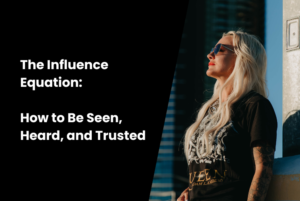With more than 5.35 billion people online and nearly 5 billion scrolling social media, one thing’s clear: your business, your organisation, and your leaders need to be showing up online. Your customers are there. Your employees are there. Your competitors? Absolutely there. If you’re not? You’re invisible—and probably being outplayed.
Here’s the kicker: 63.9% of the world’s population is using social media, and the average person is spending 2 hours and 21 minutes on it every day (Smart Insights, 2024). That’s not just a window of opportunity—it’s a massive blinking billboard screaming “Be seen!”
Treating social media like a “nice to have” is like skipping your car service and then acting surprised when it doesn’t start. It’s not just a marketing channel—it’s your visibility vehicle. If you want trust, reach, and relevance, it needs attention. And it needs it now.
The good news? Most of what’s holding you back is fixable. The bad news? These five mistakes are still way too common. So let’s call them out—and get your strategy back on track.
1. Being Too General
Here’s a classic mistake: trying to appeal to everyone. “We serve people from ages 2 to 92!” sounds inclusive but is utterly useless on social media. It’s like handing out car wrenches in a shopping centre and hoping someone bites. Most people don’t need one—and you’ve just wasted your breath (and budget).
Get specific. Drill down to a real audience. Not just demographics—actual humans with needs, habits, and scroll-time. Start with a tight age band (like 35–45-year-old parents of young kids), then tailor your messaging to them. The clearer you are, the faster you cut through.
2. Being too buttoned-up
Some organisations still believe the best way to appear professional is to be faceless. No people, no personality, just logos and carefully vetted “brand speak.”
Here’s the thing: people want to know who they’re dealing with. Show them the humans behind the handle. Run a “meet the team” series. Share a “day in the life.” Show the people that make the magic happen.
Professionalism isn’t about being robotic. It’s about being real and reliable. Trust is built when people feel like they’re dealing with people—not a policy.
3. Giving Off ‘Corporate Cold’
We get it. You’ve got a tone of voice, brand guidelines, and layers of approval. But being warm, personable—or even a little cheeky—can make you more trusted, not less.
Let’s say someone drops a spicy comment on your post. If you reply as “The Company,” it’s cold. But if your social media manager signs off with their name? It’s human. And that’s the difference between an escalation and a conversation.
Don’t hide behind the brand. Use warmth, humour, and empathy where it makes sense. People connect with people—not policies.
4. Posting Random Stuff That Doesn’t Connect
Social media isn’t about playing digital pin-the-tail-on-the-donkey. You can’t throw content into the void and hope something sticks. Everything you post needs to support your brand message.
Start with a content strategy. What do you want to be known for? What problems do you solve? What stories do you want to tell? Build content pillars and stick to them. Then layer in your personality, your perspective, and your team.
You can still have fun—just keep it aligned.
5. Inconsistency
This is the silent killer of all social media momentum. Showing up sporadically—or only when someone “has time”—is a fast track to being forgotten. Algorithms love consistency. So does your audience.
No, you don’t need to post 17 times a day. But yes, you do need to show up regularly, with a mix of planned and real-time content. Pre-schedule your core posts and layer in the spontaneous stuff as it happens.
The goal? Be findable. Be reliable. Be active.
Social media doesn’t reward perfection. It rewards participation. And the organisations that win are the ones willing to act like people—not polished press releases.
So stop overthinking. Start showing up.
Nicola Moras is a motivational keynote speaker and author of Visible and Into the Spotlight. She empowers leaders and entrepreneurs to create the gasp, be unforgettable, and own their impact—so they can build bold, unstoppable success.



